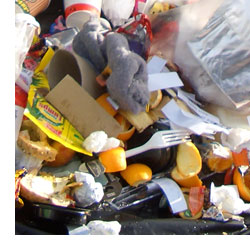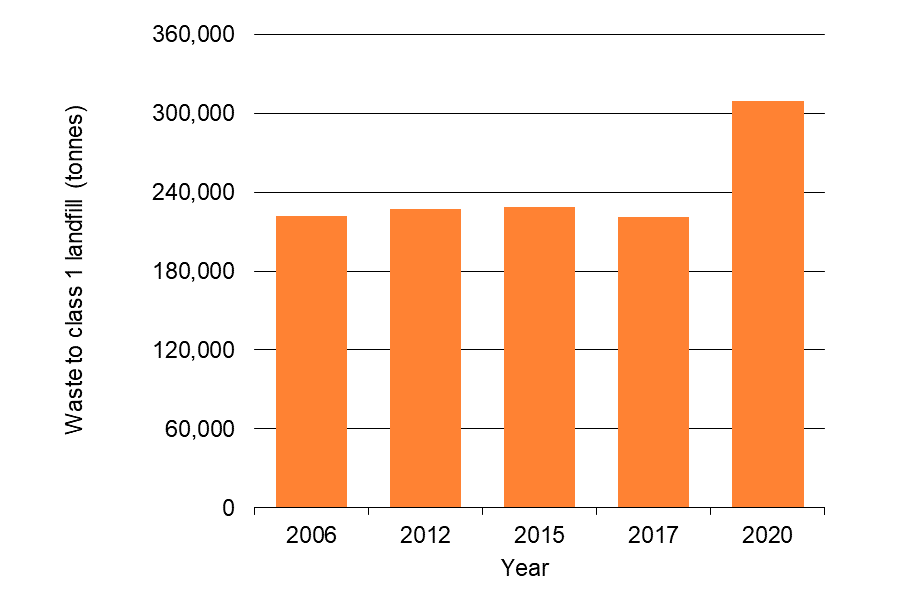Waste

 WASTE
WASTE
|
WORSENING TREND |
The estimated total amount of waste going into landfills in the Waikato region annually was substantially higher in 2020 compared to earlier monitoring.
This indicator is the estimated tonnage of waste to class 1 landfill per year in the Waikato region.
Why is this indicator important?
When waste ends up in our landfills, it can indicate how efficiently or inefficiently we are using our resources. This is particularly concerning when discarding reusable and recyclable materials such as paper, plastic, organic waste, glass and metal.
It’s not just the inefficient use of resources that is of concern. Some forms of waste produce greenhouse gases (which can affect climate change) and others can have significant health impacts on humans and animals. We also need to manage our waste effectively to avoid it polluting the Waikato region’s waterways, air and land.
Monitoring what’s being thrown out and what’s being recycled can inform territorial councils’ waste management and minimisation plans including identifying what extra support people need to make waste reduction easier. It can also help councils to focus how they provide the right information and education to people in the Waikato region to increase awareness about effective use (and reuse) of resources and the actions they can take to do this.
Waste

| Year | Waste to landfill (tonnes) |
|---|---|
| 2006 | 222,000 |
| 2012 | 226,887 |
| 2015 | 228,723 |
| 2017 | 220,741 |
| 2020 | 308,885 |
What is this indicator telling us?
- The amount of municipal waste generated in a country is related to the rate of urbanisation, types and patterns of consumption, household revenue and lifestyles.
- Most local territorial authorities have identified an increase in the amount of material going to landfill since 2012.
- An increase of waste to landfill is due to multiple factors. Cheap consumer goods are readily available without clear indication of environmental impact to the consumer, and few mandatory product stewardship schemes are in place to ensure resources are diverted. The increased transparency about how recycling has been managed overseas has resulted in necessary regulation of recyclables going offshore, affecting an already unstable recycling market that competes with the fluctuating price of new raw materials.
- 30% of the waste going to class 1 landfills is from industrial and commercial sources, 28% is from kerbside residential collection, and 17% is from construction and demolition sources (Regional Waste Stocktake, 2021).
- We could reduce waste by 41% if we removed everything that was divertible or recyclable. This would mean an almost 50% reduction in emissions from landfill, not including the emissions created from transporting waste.
- Organic waste was the largest single component of overall waste (from both residential and commercial sources) to landfill from the Waikato region, being an estimated 22% of the total.
- According to OECD data on municipal waste amounts per capita, New Zealand has one of the highest levels of municipal waste in the OECD. In 2018, New Zealand recorded 756 kg per capita of municipal waste compared to the OECD average of 535.
DATA SOURCE AND SUPPORTING INFORMATION
The 2006, 2012 and 2017 figures were taken from Bay of Plenty and Waikato Regions Waste Stocktake, prepared for Bay of Plenty and Waikato regional councils by Waste Not Consulting and Eunomia Research & Consulting. The tonnage in the stocktake was estimated using a range of sources and a limited amount of primary research. Tonnages for several of the districts were taken directly from the councils’ most recent waste assessments.
Tonnage data for 2015 was sought directly from all landfills to which waste from Waikato region is known to be taken for disposal.
2020 data is from the Waikato and Bay of Plenty Regional Waste and Recycling Stocktake 2021 prepared by Sunshine Yates consulting, Eunomia, and Waste Not Consulting.
Waste data is patchy and the current level of data is likely to be insufficient for properly managing Waikato and Bay of Plenty regions’ waste streams into the future. There are a number of reasons for the poor waste data held by district councils, including commercial sensitivities due to contracting out of waste management services. For a discussion on gaps and barriers see section 7 of the Waikato and Bay of Plenty Waste and Recycling Stocktake 2021.
These estimates are total tonnage of waste to landfill per annum (i.e. no population adjustment).
Seemingly comparable national data (assessed on a population basis) were reported in 2012 by Ministry for the Environment (MfE). No further updates of national waste data are available.
Update details: Data available for 2006, 2012, 2015, 2017 and 2020.
Customised data request requirements: Regional data are not readily available and will therefore need to be commissioned.
DATA AVAILABILITY – OTHER THAN WAIKATO REGION:
Territorial Authority (TA) disaggregation: No
Other regions: Bay of Plenty only.
New Zealand: Yes
Other countries/ Organisation for Economic Co-operation and Development (OECD): Secondary statistics from OECD municipal waste statistics.


To ask for help or report a problem, contact us
Tell us how we can improve the information on this page. (optional)